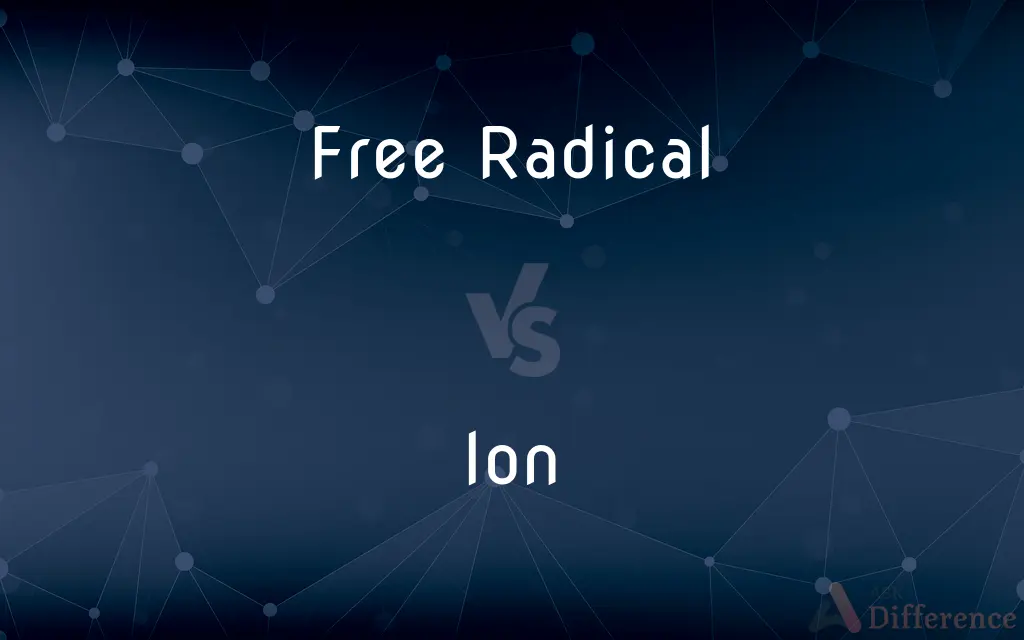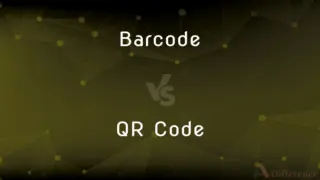Free Radical vs. Ion — What's the Difference?
By Tayyaba Rehman — Published on January 7, 2024
Free Radicals are atoms or molecules with an unpaired electron, highly reactive. Ions are atoms or molecules that have gained or lost electrons, resulting in a net charge.

Difference Between Free Radical and Ion
Table of Contents
ADVERTISEMENT
Key Differences
Free Radical: Consists of atoms or molecules with an unpaired electron in their outer shell, making them extremely reactive. Ion: An atom or molecule that has lost or gained one or more electrons, resulting in a positive or negative charge.
Free Radical: Highly reactive due to the presence of an unpaired electron, seeking to pair it, which can lead to chain reactions. Ion: Its reactivity depends on the charge and the desire to return to a neutral state. Ions can be relatively more stable than free radicals.
Free Radical: Formed through the breaking of a chemical bond in such a way that each fragment keeps one electron, often caused by heat, light, or chemical reactions. Ion: Formed when an atom or molecule gains or loses electrons, often through chemical reactions or the influence of an electric field.
Free Radical: Often initiates chain reactions and can cause significant changes in the structure of molecules, widely involved in combustion, polymerization, and aging processes.Ion: Participates in ionic bonding and is crucial in various chemical and biological processes, including electricity conduction in solutions.
Free Radical: Associated with cell damage and aging, playing a role in various health conditions. Ion: Vital in biological functions but can be harmful in excessive amounts or certain forms, such as heavy metal ions.
ADVERTISEMENT
Comparison Chart
Nature
Atom/molecule with an unpaired electron
Atom/molecule with a net charge
Reactivity
Highly reactive
Reactivity varies depending on the charge
Formation
Breaking of bonds, keeping one electron
Gain or loss of electrons
Role in Reactions
Initiates chain reactions, alters structures
Participates in ionic bonding, various roles
Impact
Can cause cell damage, involved in aging
Essential in biology, some forms can be toxic
Compare with Definitions
Free Radical
A molecule or atom that can initiate chain reactions.
The formation of free radicals in the atmosphere contributes to pollution.
Ion
Atoms or molecules that have become charged.
The ionization of atoms in the upper atmosphere creates the aurora.
Free Radical
A byproduct of various chemical reactions, often causing damage.
UV radiation can cause the formation of harmful free radicals in the skin.
Ion
Charged particle in an electric field.
Ions are essential for the conduction of electricity in electrolyte solutions.
Free Radical
An atom or molecule with at least one unpaired electron.
Oxygen molecules in the body can form free radicals leading to oxidative stress.
Ion
Key player in chemical reactions, especially in solutions.
Hydrogen ions determine the pH level of a solution.
Free Radical
Highly reactive chemical species due to unpaired electrons.
Free radicals are often implicated in the process of aging.
Ion
An atom or molecule with a net electric charge due to electron loss or gain.
Sodium chloride dissolves in water to form sodium and chloride ions.
Free Radical
Unstable and reactive molecule with an unpaired electron.
Antioxidants help neutralize free radicals to prevent cell damage.
Ion
An essential component in biological systems for various functions.
Calcium ions play a crucial role in muscle contraction.
Ion
An atom or a group of atoms that has acquired a net electric charge by gaining or losing one or more electrons.
Ion
An atom or group of atoms bearing an electrical charge, such as the sodium and chlorine atoms in a salt solution.
Ion
An atom or goup of atoms (radical) carrying an electrical charge. It is contrasted with neutral atoms or molecules, and free radicals. Certain compounds, such as sodium chloride, are composed of complementary ions in the solid (crystalline) as well as in solution. Others, notably acids such as hydrogen chloride, may occur as neutral molecules in the pure liquid or gas forms, and ionize almost completely in dilute aqueous solutions. In solutions (as in water) ions are frequently bound non-covalently with the molecules of solvent, and in that case are said to be solvated. According to the electrolytic dissociation theory, the molecules of electrolytes are divided into ions by water and other solvents. An ion consists of one or more atoms and carries one unit charges of electricity, 3.4 x 10-10 electrostatic units, or a multiple of this. Those which are positively electrified (hydrogen and the metals) are called cations; negative ions (hydroxyl and acidic atoms or groups) are called anions.
Ion
One of the small electrified particles into which the molecules of a gas are broken up under the action of the electric current, of ultraviolet and certain other rays, and of high temperatures. To the properties and behavior of ions the phenomena of the electric discharge through rarefied gases and many other important effects are ascribed. At low pressures the negative ions appear to be electrons; the positive ions, atoms minus an electron. At ordinary pressures each ion seems to include also a number of attached molecules. Ions may be formed in a gas in various ways.
Ion
A particle that is electrically charged (positive or negative); an atom or molecule or group that has lost or gained one or more electrons
Common Curiosities
What is a free radical?
A free radical is an atom or molecule that has an unpaired electron, making it highly reactive.
What makes a free radical reactive?
A free radical's reactivity is due to its unpaired electron, making it seek stability through reactions.
What is an ion?
An ion is an atom or molecule that has gained or lost one or more electrons, resulting in a positive or negative charge.
What is ionization?
Ionization is the process by which an atom or a molecule acquires a negative or positive charge by gaining or losing electrons.
How do antioxidants affect free radicals?
Antioxidants neutralize free radicals by donating electrons to them, thus reducing their reactivity and potential damage.
How are free radicals formed?
Free radicals are formed by the breaking of chemical bonds, leading to fragments with unpaired electrons, often triggered by heat, light, or certain chemical reactions.
What makes free radicals highly reactive?
The presence of an unpaired electron in free radicals makes them seek other electrons to pair with, leading to high reactivity.
How do ions form?
Ions form when atoms or molecules gain or lose electrons.
Are free radicals always harmful?
Free radicals can be harmful by causing cellular damage, but they also play roles in certain beneficial processes.
How are ions formed?
Ions are formed when atoms or molecules either lose electrons (becoming positively charged) or gain electrons (becoming negatively charged).
How are ions used in everyday technology?
Ions are used in batteries, electrolysis processes, and various types of sensors and electronic devices.
What are the typical reactions involving ions?
Ions typically participate in ionic bonding, electrochemical reactions, and act as essential elements in various biological processes.
Can free radicals be found in the environment?
Yes, free radicals are found in the environment, often as pollutants or byproducts of various chemical reactions.
What role do ions play in the human body?
Ions are vital for various bodily functions, including nerve impulse transmission, muscle contraction, and maintaining fluid balance.
Can free radicals be beneficial?
Yes, free radicals can be beneficial, like in fighting infections or signaling processes in cells.
What is the difference between an anion and a cation?
An anion is a negatively charged ion (gained electrons), while a cation is a positively charged ion (lost electrons).
Do free radicals play a role in aging?
Yes, free radicals are involved in the aging process, as they can cause cellular damage over time.
Share Your Discovery

Previous Comparison
Barcode vs. QR Code
Next Comparison
Amorphous Solids vs. Crystalline SolidsAuthor Spotlight
Written by
Tayyaba RehmanTayyaba Rehman is a distinguished writer, currently serving as a primary contributor to askdifference.com. As a researcher in semantics and etymology, Tayyaba's passion for the complexity of languages and their distinctions has found a perfect home on the platform. Tayyaba delves into the intricacies of language, distinguishing between commonly confused words and phrases, thereby providing clarity for readers worldwide.












































